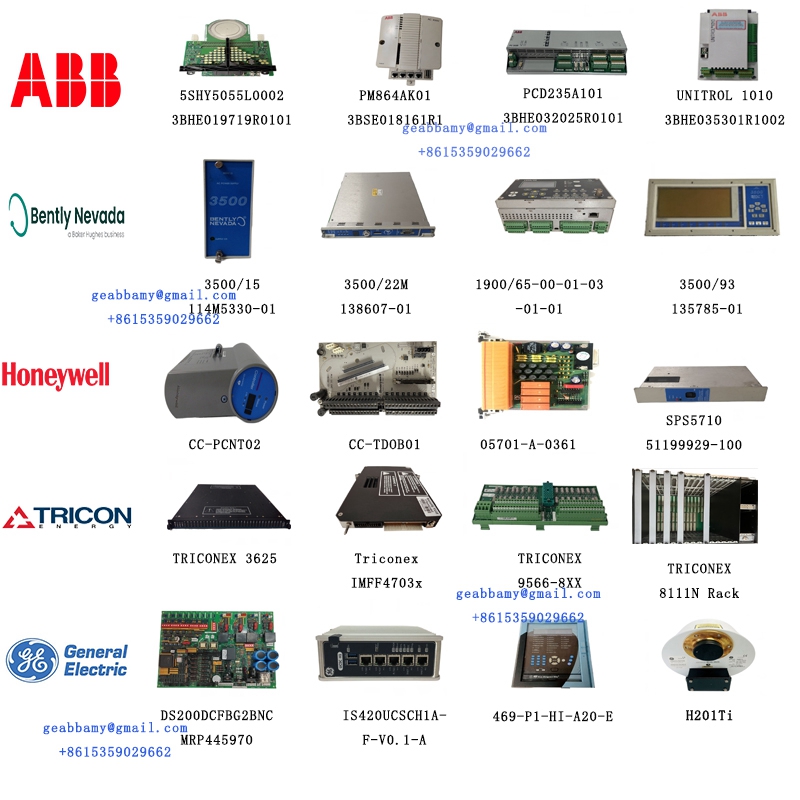Technical Specifications for GENERAL ELECTRIC F60 FEEDER MANAGEMENT RELAY (Model: F60N03VLLF8MH6BMXXR7J) - NEW
1. Overview
The GENERAL ELECTRIC (GE) F60 Feeder Management Relay, model F60N03VLLF8MH6BMXXR7J, is a sophisticated protective device designed for monitoring and safeguarding electrical distribution feeders in industrial and utility power systems. It combines advanced protection, control, and communication capabilities to ensure reliable operation and rapid fault detection.
2. Key Technical Parameters
2.1 Protection Functions
- Overcurrent Protection (50/51)
- Instantaneous, definite-time, and inverse-time overcurrent elements.
- Adjustable pickup settings and time delays.
- Earth Fault Protection (50N/51N)
- Sensitive ground fault detection with adjustable thresholds.
- Voltage Protection (27/59)
- Undervoltage and overvoltage monitoring with programmable trip delays.
- Frequency Protection (81)
- Overfrequency and underfrequency protection to prevent generator damage.
- Thermal Overload Protection (49)
- Accumulative thermal modeling to protect against prolonged overcurrent conditions.
- Breaker Failure Protection (50BF)
- Detects breaker failure and initiates backup tripping.
2.2 Input/Output (I/O) Configuration
- Digital Inputs (DIs)
- Configurable for functions like block signals, remote reset, or external trip commands.
- Digital Outputs (DOs)
- Relay contacts for tripping, alarm indication, and status signaling.
- Analog Inputs/Outputs (AIs/AOs)
- Optional support for voltage/current measurement and control signals.
2.3 Communication Interfaces
- IEC 61850-Compliant Ethernet Port
- Supports GOOSE messaging and MMS for seamless integration with SCADA systems.
- Modbus RTU/TCP
- Serial communication for legacy system compatibility.
- DNP3 Protocol (Optional)
- Enhanced data exchange for advanced monitoring.
- Front-Panel USB/RS-232 Ports
- For local configuration and firmware updates.
2.4 Power Supply
- Dual Redundant Power Inputs
- AC/DC operation (e.g., 48–250 V DC or 85–265 V AC).
- Wide operating range for high reliability.
2.5 Environmental Specifications
- Operating Temperature: -20°C to +70°C (-4°F to +158°F).
- Storage Temperature: -40°C to +85°C (-40°F to +185°F).
- Humidity: 5% to 95% non-condensing.
- Altitude: Up to 3,000 meters (10,000 feet) without derating.
2.6 Mechanical Specifications
- Enclosure: IP54-rated (NEMA 4X optional) for harsh environments.
- Mounting: DIN rail or panel mount.
- Dimensions: Standard 19-inch rack-mountable or compact form factor.
2.7 Approvals and Standards
- Compliance: IEC 60255, IEEE C37.2, UL 508, CE, and other regional standards.
- EMC Compliance: EN 61000-6-2 (Immunity), EN 61000-6-4 (Emission).
2.8 Software Features
- User-Friendly HMI:
- Color touchscreen display for local configuration and status monitoring.
- Programmable Logic:
- Support for custom logic sequences via ladder diagrams or function blocks.
- Event Recording:
- High-speed oscillography and disturbance recording (up to 100 events).
- Cybersecurity:
- Role-based access control, secure communication protocols (TLS/SSL), and firmware integrity checks.
3. Applications
- Industrial Power Distribution: Protection of feeders in manufacturing plants, oil refineries, and mining operations.
- Utility Substations: Integration with medium-voltage switchgear for grid reliability.
- Renewable Energy Systems: Protection of feeders in solar/wind farms.
- Critical Infrastructure: Hospitals, data centers, and airports requiring high uptime.
4. Advantages
- High Accuracy: Sub-cycle fault detection (<1 cycle).
- Scalability: Modular design for future upgrades.
- Low Maintenance: Self-diagnostic capabilities and long-life components.
- Global Support: Backed by GE’s extensive service network.
5. Ordering Information
- Model Number: F60N03VLLF8MH6BMXXR7J (NEW).
- Customization Options:
- Additional communication modules (e.g., IEC 61850, DNP3).
- Extended temperature range (-40°C to +85°C).
- Special enclosure ratings (e.g., ATEX for hazardous areas).
This relay is ideal for applications demanding robust protection, advanced communication, and ease of use. For detailed technical drawings or additional customization, refer to GE’s official product documentation or contact their sales/engineering team.
Note: For exact specifications, always verify with GE’s latest product datasheet, as firmware updates or regional variants may affect parameters.


